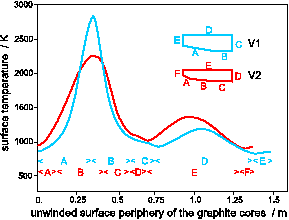| Calculations of the Power Dissipation and the Temperature Distribution in Beam Dumps at ELBE | |||||||||||||||||||||
|---|---|---|---|---|---|---|---|---|---|---|---|---|---|---|---|---|---|---|---|---|---|
| B. Naumann1, M. Werner2 | |||||||||||||||||||||
|
The beam dumps for ELBE must be capable of absorbing an
average beam power of 50 kW at an electron beam energy of 50 MeV. After passing a
500 mm thick beryllium foil the incident electron beam
enters a purified graphite absorber
(r = 1.7 g/cm3). The power dissipation for a first design of the beam dump was
calculated using the particle transport code GEANT [1,2].
Further calculations have been performed with the transport code FLUKA [3], which makes possible to
consider nuclear reactions like the (g,n) process. Two geometrical shapes of the
graphite core (V1, V2) have been compared with respect to the power dissipation and the temperature
distribution. Version V1 corresponds to the first layout [1] with a radius of 15 cm and a
cone-shaped hole of 35 cm depth. The power dissipation for V1 is shown in Fig. 1. After
reducing of the radius to 10 cm, the implementation of a second cone-shaped hole at
the entrance (10 cm deep) and the
elongation of the first cone-shaped hole up to 45 cm, the power dissipation in this version V2
is more homogeneously distributed as shown in Fig. 2.
1 Institut für Kern- und Teilchenphysik, TU Dresden
References
|
|||||||||||||||||||||

